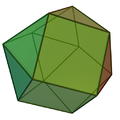Forms
In the first column of the two following tables, the symbols are Schoenflies, Coxeter, and orbifold notation, in this order.
Set of orthobicupolae
| Symmetry | Picture | Description |
|---|---|---|
| D3h [2,3] *223 |  | Triangular orthobicupola (J27): 8 triangles, 6 squares. [1] [2] Its dual is the trapezo-rhombic dodecahedron |
| D4h [2,4] *224 |  | Square orthobicupola (J28): 8 triangles, 10 squares. [2] |
| D5h [2,5] *225 |  | Pentagonal orthobicupola (J30): 10 triangles, 10 squares, 2 pentagons. [2] |
| Dnh [2,n] *22n | n-gonal orthobicupola: 2n triangles, 2n rectangles, 2 n-gons |
Set of gyrobicupolae
An n-gonal gyrobicupola has the same topology as an n-gonal rectified antiprism, Conway polyhedron notation: aAn.[ clarification needed ]
| Symmetry | Picture | Description |
|---|---|---|
| D2d [2+,4] 2*2 |  | Gyrobifastigium (J26) or digonal gyrobicupola: 4 triangles, 4 squares.[ citation needed ] |
| D3d [2+,6] 2*3 |  | Triangular gyrobicupola or cuboctahedron: 8 triangles, 6 squares. [1] [2] Its dual is the rhombic dodecahedron. |
| D4d [2+,8] 2*4 |  | Square gyrobicupola (J29): 8 triangles, 10 squares. [2] Its dual is the elongated tetragonal trapezohedron |
| D5d [2+,10] 2*5 | | Pentagonal gyrobicupola (J31): 10 triangles, 10 squares, 2 pentagons. [2] Its dual is the elongated pentagonal trapezohedron |
| Dnd [2+,2n] 2*n | n-gonal gyrobicupola: 2n triangles, 2n rectangles, 2 n-gons. |